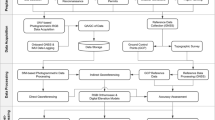Abstract
Terrestrial photogrammetry should be the survey technique of choice when updating large scale urban maps and GIS databases, where 3D data and attribute data are required. Its main drawback is the need for Ground Control Points (GCP) to reference the survey. To make image georeferencing easier and to provide control information, the use of a simple system, made of a photogrammetric camera fastened to a GPS antenna, is proposed. A photogrammetric block, composed by at least three images, is taken around the object with the receiver measuring in kinematic mode. Tie points are automatically extracted by Structure from Motion (SfM) algorithms or measured manually; block orientation is performed by GPS assisted Aerial Triangulation. Advantages as well as limitations of the system are discussed, with particular attention to GPS availability or ill-conditioned block configurations. The issue of system calibration (i.e. measurement of eccentricity between camera and antenna) is also addressed. Several test cases are presented, in which absolute accuracies, verified on check points independently surveyed range from 4 to 7 cm.











Similar content being viewed by others
References
Ackermann F (1984) Utilization of navigation data for aerial triangulation. International Archives of Photogrammetry and Remote Sensing, ISPRS Commission III, Vol. 25, Part A3a, Rio de Janeiro, pp. 1–9.
Agarwal S, Furukawa Y, Snavely N, Simon I, Curless B, Seitz SM, Szeliski R (2011) Building Rome in a day. Communications of the ACM 54(10):105–112
Bay H, Ess A, Tuytelaars T, Van Gool L (2008) SURF: Speeded up robust features. Computer Vision and Image Understanding (CVIU) 110(3):346–359
Beis JS, Lowe DG, (1997) Shape indexing using approximate nearest-neighbour search in high-dimensional spaces. In: Proc.of CVPR 1997, pp. 1000–1006.
Biagi et al. (2006) Il Servizio di Posizionamento in Regione Lombardia e la prima sperimentazione sui servizi di rete in tempo reale. Bollettino della SIFET n° 1, 2006
Buckley SJ, Vallet J, Wheeler W, Braathen A (2008) Oblique helicopter-based Laser scanning for digital terrain modeling and visualization of geological outcrops, The Internal Archives of the Photogrammetry, remote sensing and Spatial Information sciences, Beijing, Commission IV/4, pp. 493–498.
Ellum C, El-Sheimy N (2000) The development of a backpack mobile mapping systems, International archives of the Photogrammetry, Remote sensing and spatial information sciences, Vol. XXXIII Part B2, (CD), Amsterdam, The Netherlands, pp. 184–191.
Ellum C, El-Sheimy N (2001) A mobile mapping system for the survey community, Proc. of The 3rd Int. Symp. on Mobile Mapping Technology, Cairo, Egypt, January 3–5, 2001, (CD).
Fischler M, Bolles R (1981) Random sample consensus: A paradigm for model fitting with application to image analysis and automated cartography. Commun Assoc Comp Mach 24(3):81–95
Forlani G, Pinto L, (1994) Experiences of combined block adjustment with GPS data. International Archives of Photogrammetry and Remote Sensing, ISPRS Commission III, Vol. 30 Part 3/1, Muenchen, pp. 219–226.
Forlani G, Pinto L (2002) Integrated INS/DGPS systems: Calibration and combined block adjustment, Proceedings, OEEPE Workshop “Integrated Sensor Orientation”, Hannover, Sept. 17–18, 2001, OEEPE Official Publication N°. 43, 2002, pp. 85–96.
Forlani G, Roncella R, Remondino F (2005) Structure and motion reconstruction of short mobile mapping image sequences, Proc. of the 7th Conf. On Optical 3D measurement techniques, Vienna, 3–5 Oct. 2005, Vichman Verlag, Vol I, pp. 265–274
Fraser CS (1997) Digital camera self-calibration. ISPRS Journal of Photogrammetry and Remote Sensing 52:149–159
Furukawa Y, Ponce J (2010) Accurate, dense, and robust multi-view Stereopsis. IEEE Transactions on PAMI, Vol. 32, Issue 8, August 2010, pp 1362–1376.
Gillet J, McCuiag R, Scherzinger B, Lithopoulos E (2001) Tightly coupled inertial/GPS system for precision forestry surveys under canopy: Test results. First International Precision Forestry Symposium, University of Washington, College of Forest Resources, Seattle, pp 131–138
Harris C, Stephens M (1988) A combined corner and edge detector. Alvey Vision Conference, pp. 147–151
Hartley R, Zisserman A (2000) Multiple view geometry in computer vision. Cambridge University Press, Cambridge, pp 1–496
Heipke C, Jacobsen K, Wegmann H (2002) Analysis of the Results of the OEEPE Test Integrated Sensor Orientation. OEEPE Official Publication, No 43:31–49
Jacobsen K (2000) Potential and limitation of direct sensor orientation, Int. Arch. of Photogrammetry and Remote Sensing, Amsterdam, The Netherlands, Vol. 33, Part B3/1, pp. 429–435
Kraus K (1997) Photogrammetry, vol 2. Dümmler, Bonn, 466 pp
Lowe D (2004) Distinctive image feature from scale-invariant keypoints. International Journal of Computer Vision 60(2):91–110
Nister D (2004) An efficient solution to the five-point relative pose problem. IEEE T, Pattern Anal 26(6):756–770
Roncella R, Re C, Forlani G (2011) Comparison of two structure and motion strategies. International Archives of Photogrammetry, Remote Sensing and Spatial Information Sciences, Volume 38-5/W16, pp. 1–8, CD-ROM
Schwarz KP, Fraser CS, Gustafson PC (1984) Aerotriangulation without ground control. International Archives of Photogrammetry and Remote Sensing, ISPRS Commission I, Vol. 25, Part A1, Rio de Janeiro, pp. 237–250.
Vallet J (2001) Design of a helicopter based portable handheld mobile system for avalanche mapping. Proc. of The 3rd Int. Symp. on Mobile Mapping Technology, Cairo, Egypt, January 3–5, 2001, (CD).
Vallet J, Skaloud J, Koelbl O, Merminod B (2000) Development of a Helicopter-based integrated system for avalanche and hazard management. International. Archives of Photogrammetry and Remote Sensing. Vol. XXXIII part B2, (CD), Amsterdam, The Netherlands, pp. 565–572
Van der Vegt HJW (1989) GPS test flight Flevoland. Schriftenreihe des Instituts für Photogrammetrie, Universität Stuttgart, Vol 13, pp. 285–298
Author information
Authors and Affiliations
Corresponding author
Additional information
Communicated by: H. A. Babaie
Rights and permissions
About this article
Cite this article
Forlani, G., Pinto, L., Roncella, R. et al. Terrestrial photogrammetry without ground control points. Earth Sci Inform 7, 71–81 (2014). https://doi.org/10.1007/s12145-013-0127-1
Received:
Accepted:
Published:
Issue Date:
DOI: https://doi.org/10.1007/s12145-013-0127-1




